Physical Address
304 North Cardinal St.
Dorchester Center, MA 02124
Physical Address
304 North Cardinal St.
Dorchester Center, MA 02124
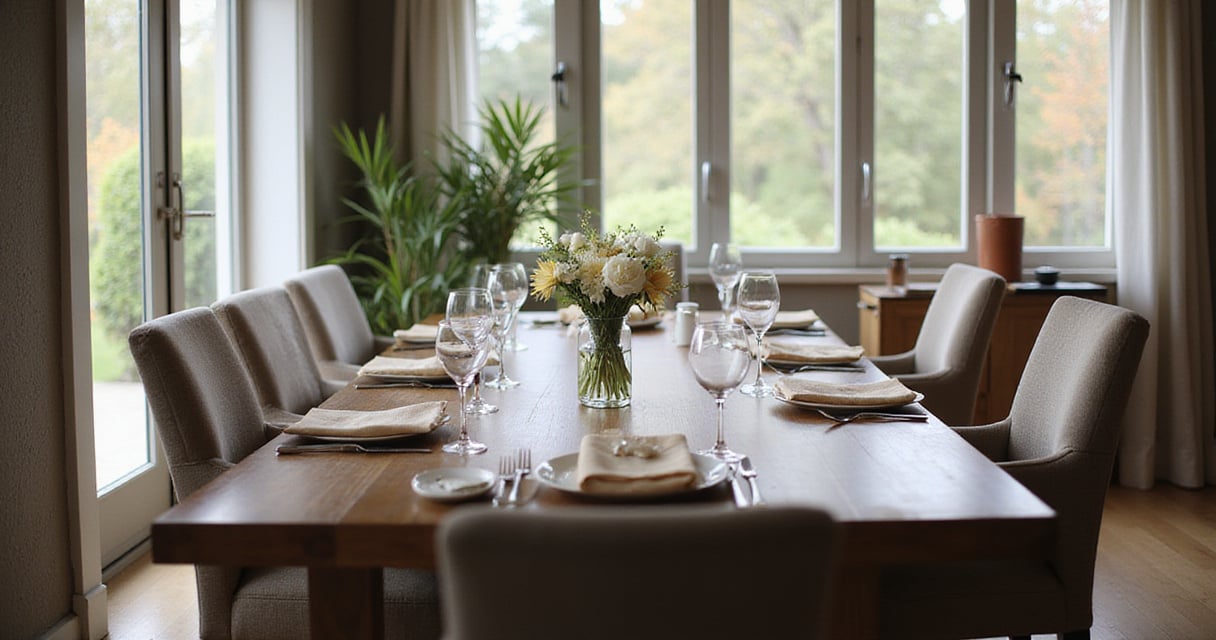
Transform your space with 21 expert contemporary dining room design secrets. From lighting to furniture selection, create a stunning modern dining area that's both functional and beautiful.
Of all the rooms in a home, the dining room holds a special kind of energy. It’s more than just a place to eat; it’s a space where we connect, share stories, and nourish ourselves and the people we love. As someone who blends meditation practice with interior design, I’ve seen firsthand how a thoughtfully designed dining room can become a true sanctuary. It can shift from a purely functional room into a space that calms the mind and opens the heart.
The contemporary dining room has shed its formal, stuffy reputation. It’s no longer a room you only use on holidays. Today, the best spaces are flexible, breathing with the rhythm of our lives. They are where we sip a quiet morning tea, where laughter erupts over a meal with friends, and where we honor the simple, sacred act of breaking bread together.
So, how do we create a room that feels as good as it looks? It’s about more than just picking out a table. It’s an act of mindfulness. Here are 21 ways I guide my clients to design a contemporary dining room that feels genuinely welcoming and deeply personal.
Your dining table is the energetic center of the room—its heart, really. Its shape is one of the first and most important decisions you’ll make, as it dictates not just how people move, but how they connect. When you get this right, you’ll feel it. Conversations flow more freely, and people just naturally want to linger.

Think about the kind of gatherings you want to have. A round table is wonderfully democratic. There’s no head of the table, so everyone feels equally part of the conversation. I find they’re perfect for fostering deep connection among smaller groups. A rectangular table is fantastic for hosting more people, but here’s the key: you must give it space to breathe. You need at least 36-42 inches between the table’s edge and the wall. Anything less, and the room feels constricted.
Here’s a little trick I always recommend: before you commit, get some painter’s tape and map out the table’s dimensions on your floor. Live with it for a day or two. Walk around it. Feel it. Does it work with your daily rhythm? This simple act can save you from a very expensive mistake.
Now that we’ve found the heart of the room, let’s make sure people actually want to stay there.
Have you ever cut a wonderful evening short because your back was aching from a terrible chair? Comfort is everything. Truly comfortable seating transforms a dining room from a place for a quick meal into a haven where people can settle in for hours. As a meditation teacher, I know that a restless body leads to a restless mind. If you can’t shift and adjust comfortably, your attention will wander, and conversation will fizzle out.
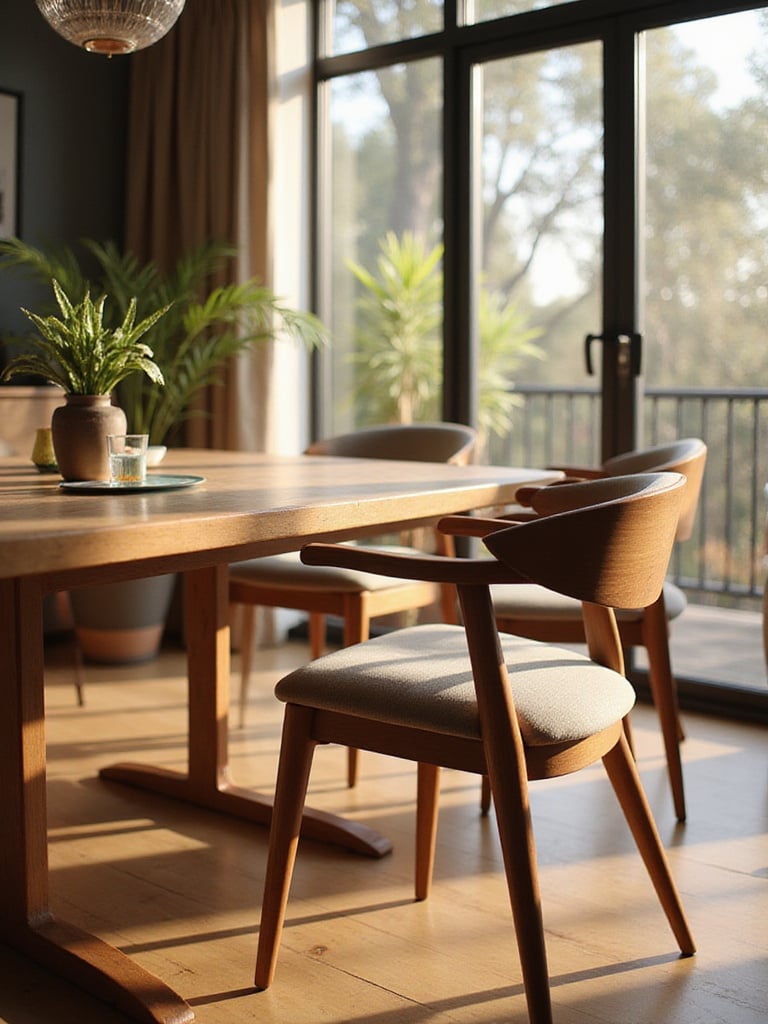
Look for chairs with gentle lumbar support—not something that feels like an office chair, but a subtle curve in the backrest that cradles your spine. Your feet should rest flat on the floor, and there should be a few inches of space between the front of the seat and the back of your knees. This prevents that antsy feeling that makes you want to get up and leave.
I had a client once who couldn’t figure out why their dinner parties always ended by 9 PM. We swapped their stylish-but-rigid wooden chairs for beautifully upholstered ones with high-density foam. The next time we spoke, they laughed and said, “We have the opposite problem now—no one ever wants to go home!” That’s the power of truly comfortable seating.
With physical comfort taken care of, let’s address the mental comfort that comes from a serene, uncluttered space.
A well-chosen sideboard or credenza is the quiet hero of a mindful dining room. It’s your secret weapon against clutter, creating a calm, designated home for everything from linens and serving platters to your favorite ceramic bowls. This keeps your table clear and your mind at ease. A clear surface invites connection; a cluttered one creates distraction.
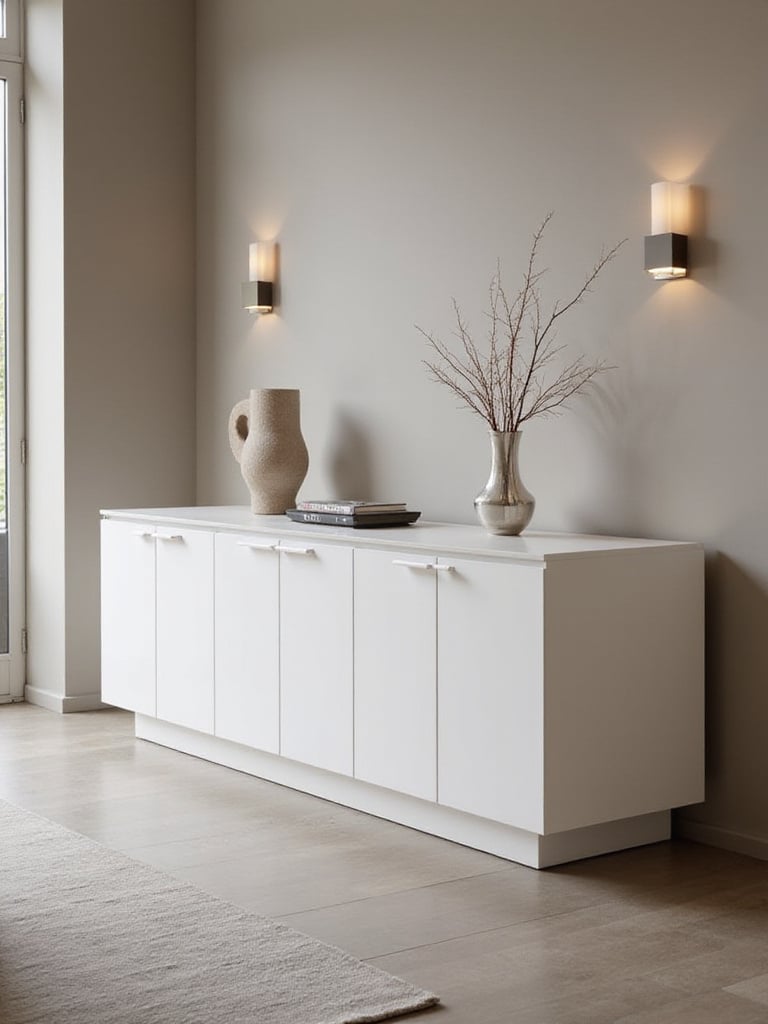
In contemporary spaces, look for pieces with clean lines and minimal hardware. It’s what’s inside that counts. I love sideboards that offer a mix of closed cabinets for hiding the daily necessities and a bit of open shelving for displaying objects that bring you joy. Think carefully about its size—it should feel substantial enough to anchor the wall it’s on, but features like raised legs or a floating design can give it a sense of lightness.
The real art is styling the surface with intention. This isn’t a storage shelf; it’s a curated moment of beauty.
Now that we have a foundation of calm, let’s bring in a piece that adds a touch of magic.
A beautiful chandelier does more than just light a room; it’s the jewelry. It’s a focal point that instantly elevates the space and gives it a soul, drawing people in and making even a simple weeknight dinner feel like a special occasion.
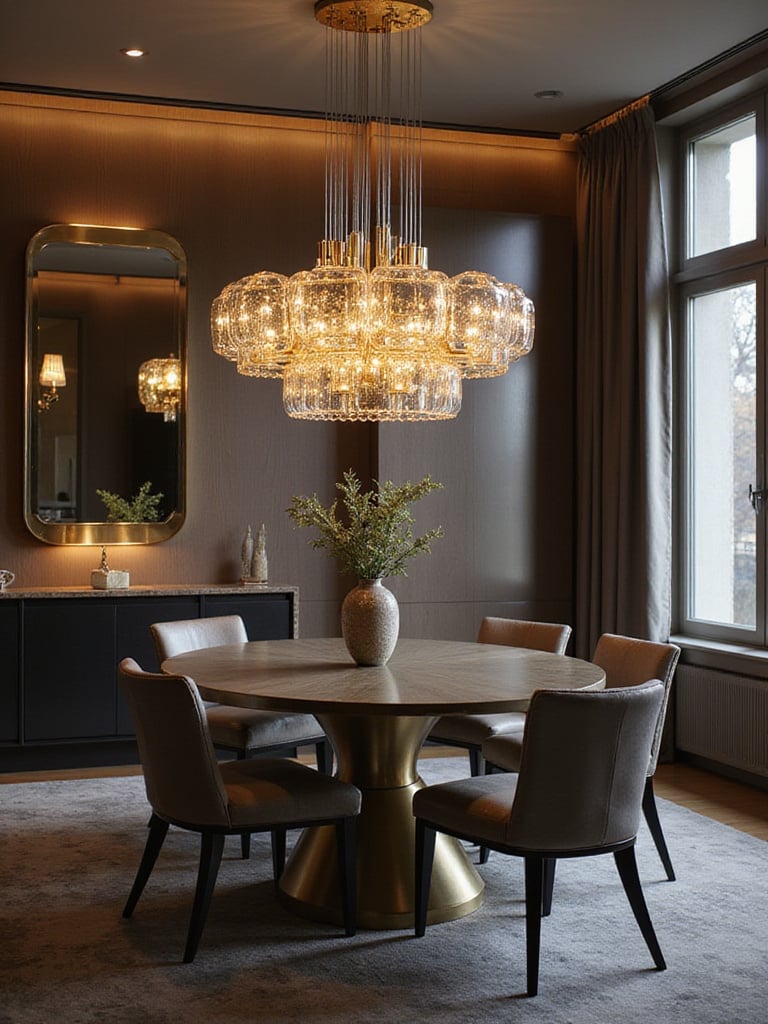
Contemporary design has moved far beyond fussy crystal. Think sculptural forms, organic shapes that echo nature, or clean linear fixtures that feel like art floating in space. It’s about finding a piece that speaks to your room’s personality.
Placement is critical. The bottom of the fixture should hang 30 to 36 inches above your tabletop. This gives you light for the meal without blocking anyone’s view across the table. And please, please install a dimmer switch. It’s the single most transformative tool in lighting. It allows you to shift the mood from bright and bustling to low and intimate with the simple turn of a dial.
“The right chandelier doesn’t just light a room; it creates an atmosphere that makes every meal feel intentional and every gathering feel special.” — Lighting Designer Randall Whitehead
With that star piece in place, we can begin to build the supporting cast of light.
Layered lighting is what separates a good room from a great one. It gives your dining space the flexibility to adapt to any situation, transforming from a bright spot for morning coffee to a soft, glowing room for a romantic dinner. It involves weaving together three types of light to create a rich, dynamic environment.
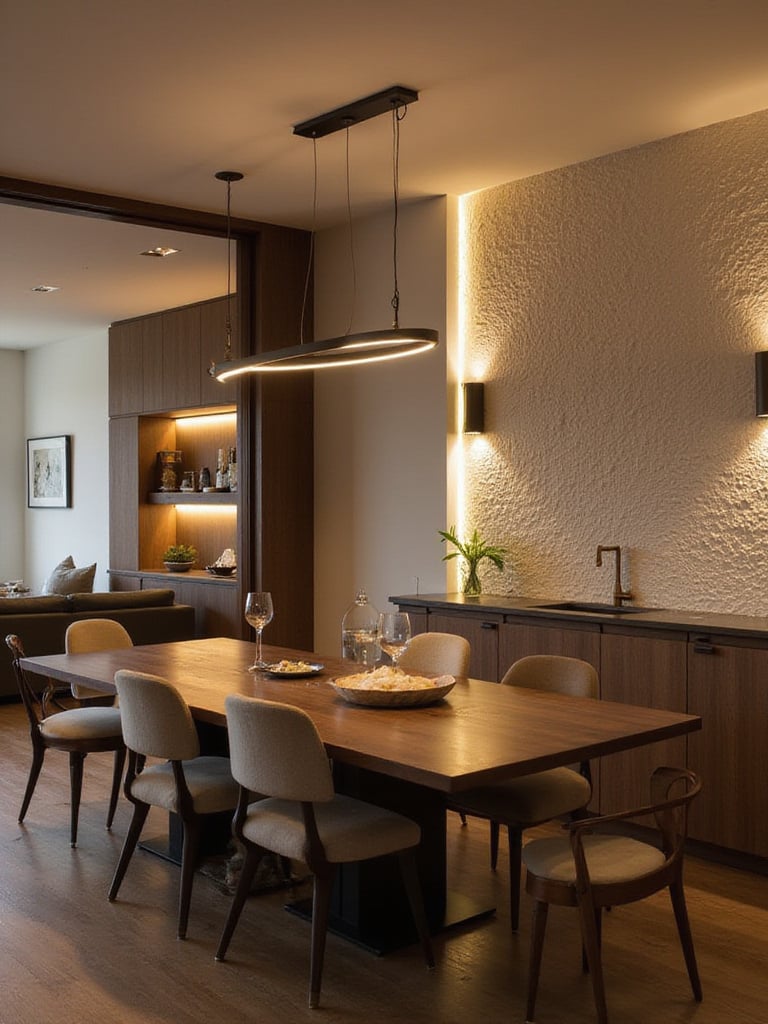
Think of it like this: ambient light is your base layer—the overall glow from recessed lights or your chandelier on a medium setting. Task lighting is more focused, like the direct light your chandelier casts on the table for dining. And accent lighting is the magic—the little spotlights that highlight a piece of art, graze a textured wall, or make a plant come alive at night.
The real power comes when you can control each layer on its own. This allows you to “paint” with light, creating different scenes for different moods. Honestly, it’s the best way to make a single room feel like many.
This idea of creating distinct moods and areas is especially important in modern homes.
How do you create a distinct dining area when you don’t have walls? The goal is to create a sense of place—an energetic boundary—without sacrificing that wonderful, airy feeling of an open floor plan.
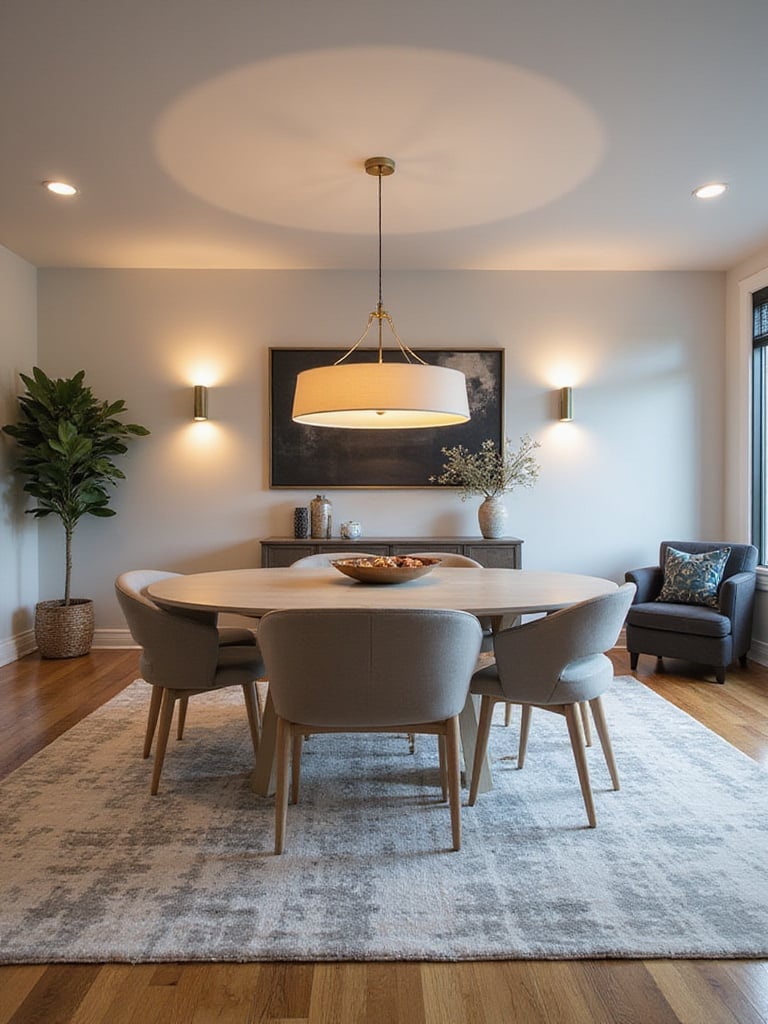
An area rug is your most powerful tool. It’s like a visual anchor that says, “This is the dining space.” Choose a rug that’s big enough for both the table and the chairs, even when they’re pulled out. This creates a cohesive foundation. You can also use furniture, like the back of a sofa or a low console table, to suggest a gentle boundary that doesn’t block sightlines.
Lighting does this, too. A stunning pendant hanging over your table instantly establishes that spot’s importance. Sometimes, even a subtle shift, like a different paint color on a single accent wall, can be enough to signal that you’ve entered a new “zone.” It’s all about creating definition without building walls.
But what if you don’t have an expansive, open-concept home?
A small dining space isn’t a curse; it’s an opportunity to create something incredibly cozy and clever. The secret is choosing furniture that’s smart about its footprint while still feeling sophisticated.
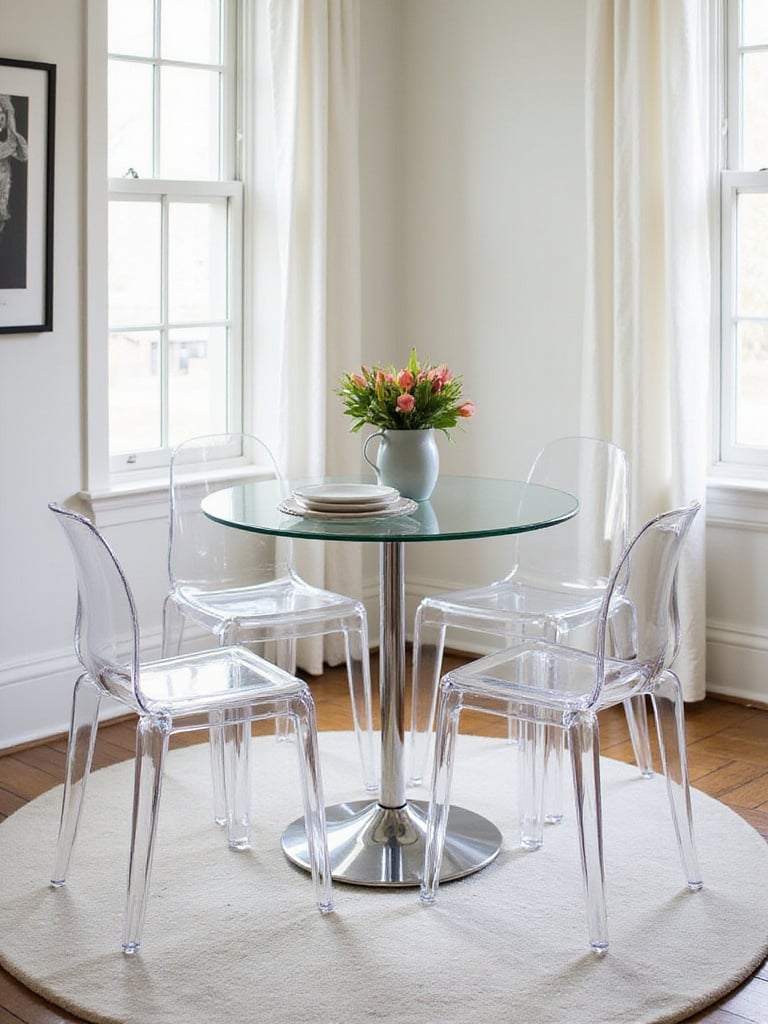
Extendable tables are a small-space lifesaver. They stay compact for daily life but are ready for guests when you need them. I’m also a huge fan of banquette seating built against a wall. It saves a ton of space since you don’t need room to pull chairs out, and you can often build in hidden storage underneath. Genius.
Another trick is to play with visual weight. Materials like acrylic or glass let light pass right through them, making furniture seem to disappear. A ghost chair or a glass-topped table can create an amazing illusion of spaciousness. Look for furniture with slim profiles or legs that lift it off the floor—seeing more floor makes any room feel bigger.
It’s often the constraints of a small space that spark the most creative and personal solutions.
Once you have your layout, you can start layering in the elements that make a room feel alive.
Natural materials are the soul of contemporary design. They are the perfect antidote to any potential coldness, infusing a room with the warmth, character, and life that only nature can provide. Our bodies instinctively respond to these materials; it’s a deep-seated connection called biophilia.
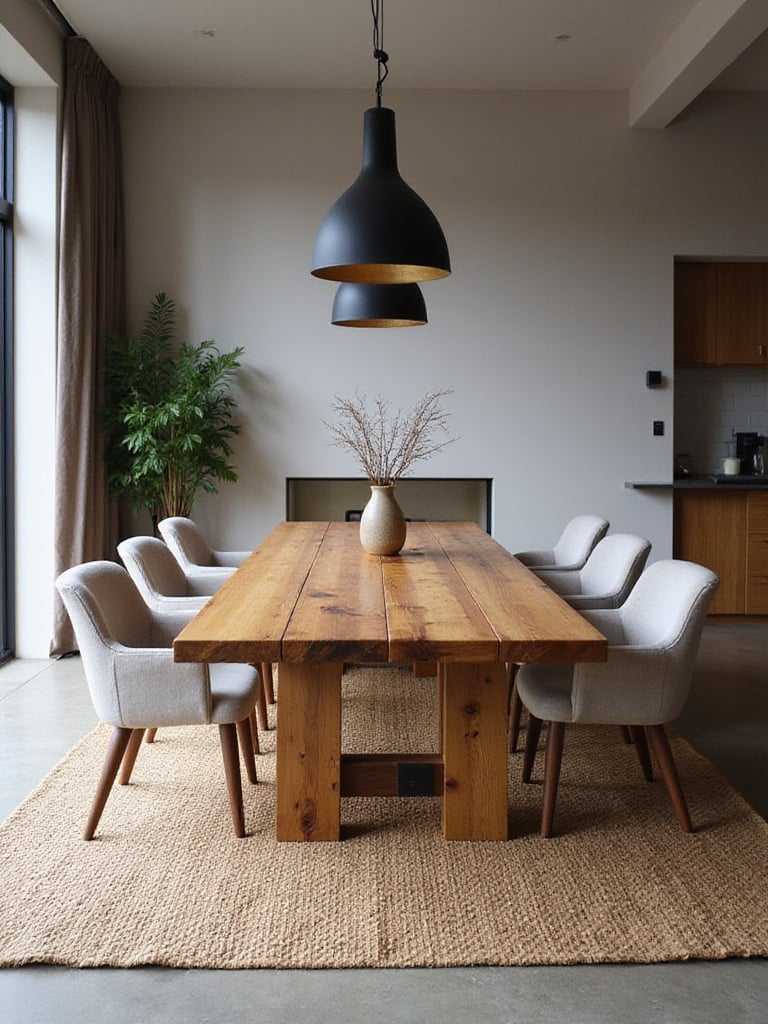
Think about layering different textures. Imagine the smooth, cool feel of a marble tabletop contrasted with the warm, rich grain of a walnut sideboard. Or the way brushed brass fixtures catch the light next to soft, nubby linen upholstery. I love to watch how these materials change throughout the day—the way morning sun rakes across a stone wall, or evening light makes the grain in a wooden chair glow.
Embrace the imperfections. It’s the unique patterns in wood, the subtle veining in stone, and the slight irregularities of a handwoven rug that tell a story. They make a space feel authentic and lived-in, not like a sterile showroom.
This natural foundation is the perfect canvas for the next layer of comfort.
Textiles are essential for turning a contemporary dining room into a warm, inviting retreat. But they do more than just add softness; they dramatically improve the room’s acoustics. Hard surfaces—wood, glass, stone—bounce sound around, creating an echoey, loud environment. Soft things—rugs, drapes, upholstered chairs—absorb that sound.

This is so important for conversation. In a room with good acoustics, you don’t have to raise your voice to be heard. The sound is softer, more intimate, encouraging connection. This is especially critical in open-concept homes, where kitchen clatter can easily bleed into your dining experience. A substantial area rug, some beautiful drapes, or upholstered seating can work wonders.
Beyond the practical, textiles provide a much-needed tactile experience. The contrast between a smooth table and a textured placemat, or a sleek metal chair and a soft wool cushion, makes a room far more engaging to our senses. They are a non-verbal cue that says, “Welcome. Stay a while.”
With visual and acoustic comfort in place, we can set the emotional tone for the room.
Color is one of the most powerful, and often overlooked, tools for shaping the mood of a space. For a dining room—a place of nourishment and connection—a serene color palette is the foundation for creating a relaxing atmosphere.
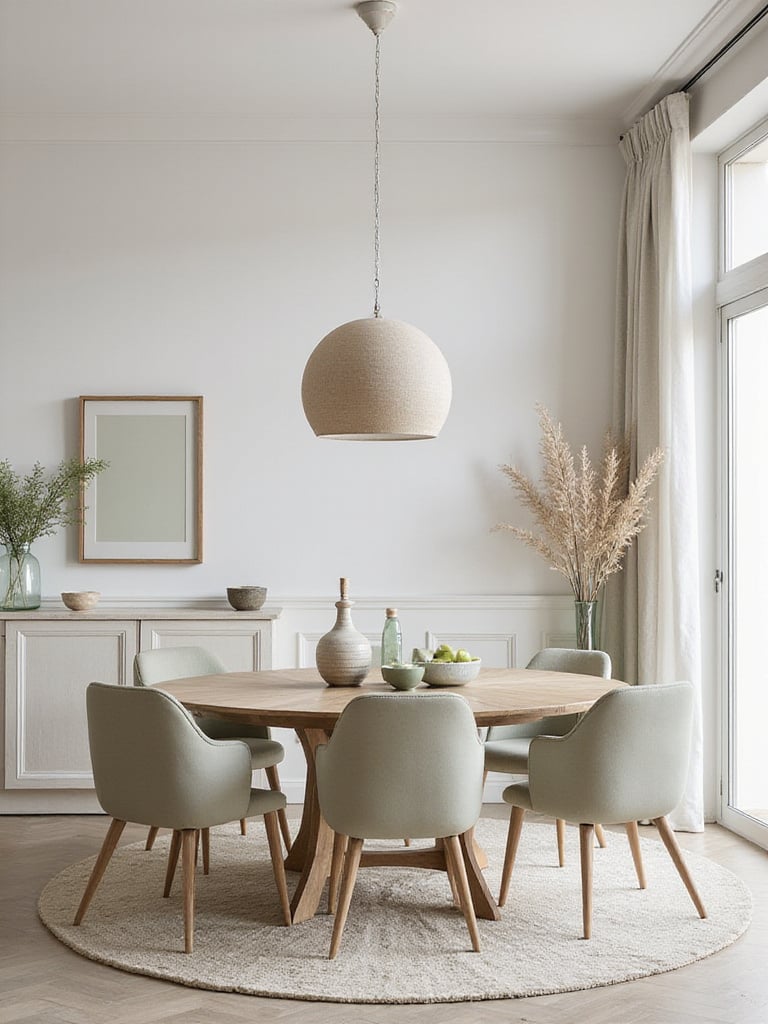
I gravitate toward soft, muted tones pulled from nature: warm whites, gentle grays, dusty blues, and sage greens. These colors have a grounding effect. They allow the mind to settle, encouraging everyone to slow down and be more present with their food and their company. The key is to create gentle shifts in tone and shade, rather than stark, high-contrast combinations that can feel jarring to the nervous system.
Here’s something to try: before you paint, get a few sample pots. Paint large swatches on different walls and live with them for a few days. See how they look in the morning light, in the bright afternoon, and under your artificial lights at night. A color’s personality can change dramatically, and you want to love it at all hours.
This quiet canvas provides the perfect stage for expressing your personality.
Artwork is the soul of a room. It transforms a well-designed space into your space. The pieces you choose are conversation starters, mood-setters, and daily reminders of what moves you. This is your chance to tell your story.
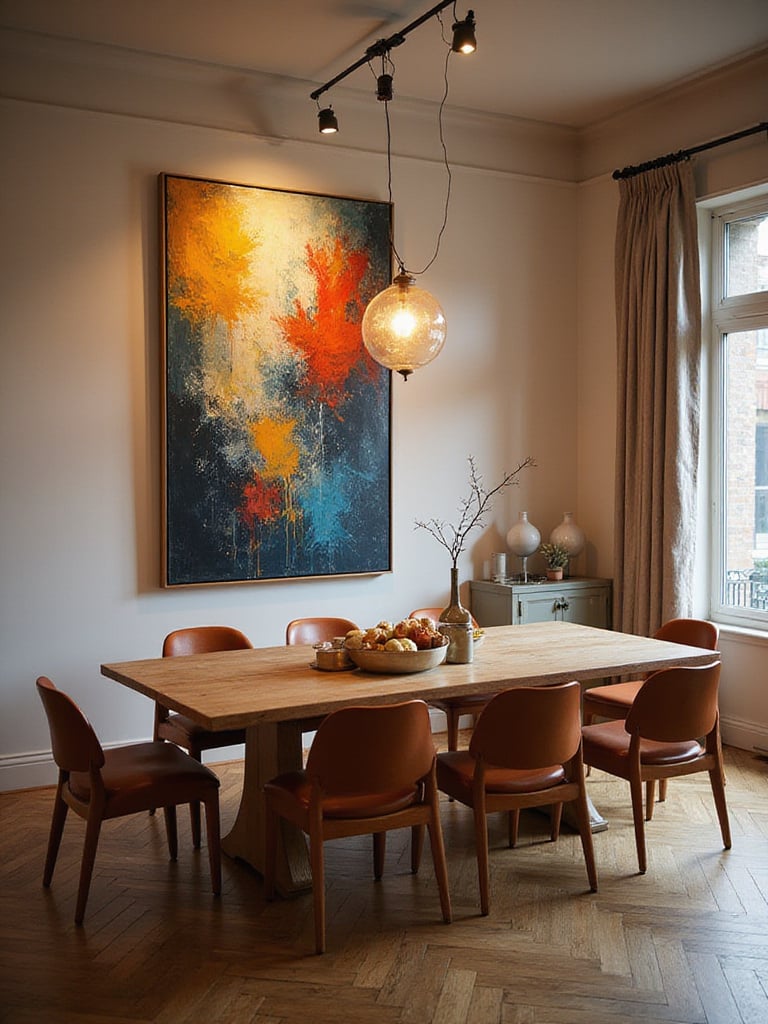
In a contemporary dining room, I often find that one large, powerful piece has more impact than a busy gallery wall. People spend a lot of time sitting and looking in a dining room, which gives them a chance to really connect with the art. A big piece can hold the wall and create a dramatic focal point.
And don’t forget to light it properly. A simple picture light can turn a beautiful painting into a breathtaking centerpiece, especially at night. Ask yourself what kind of energy you want to bring to your meals. Do you want something vibrant and energizing that sparks conversation, or a more calming, contemplative piece that encourages quiet reflection? There’s no wrong answer—it just has to be your answer.
Building on that personal expression, let’s bring in some life.
Plants are living sculptures. They bring a dynamic, breathing energy into a contemporary room that static objects just can’t match. They also happen to clean the air and foster that sense of well-being that comes from having nature nearby.

Look for plants with strong, architectural shapes that complement modern design. The upright lines of a snake plant, the huge, sculptural leaves of a fiddle leaf fig, or the soft, cascading lines of a pothos vine can all work beautifully. The key is to be honest with yourself. Choose plants that will thrive in your room’s light conditions and match your ability to care for them. A sad, dying plant is much worse than no plant at all!
Place them strategically. A tall floor plant can soften a hard corner, while a small group of plants on a sideboard can create a lovely living vignette. And pay attention to the pots! A beautiful ceramic or concrete planter can be as much a part of the design as the plant itself.
This idea of living, breathing elements extends to how your furniture functions.
Multi-functional furniture is the heart of smart contemporary design. It allows your dining room to be more than just a dining room, adapting to the full spectrum of modern life while keeping that clean, uncluttered aesthetic.
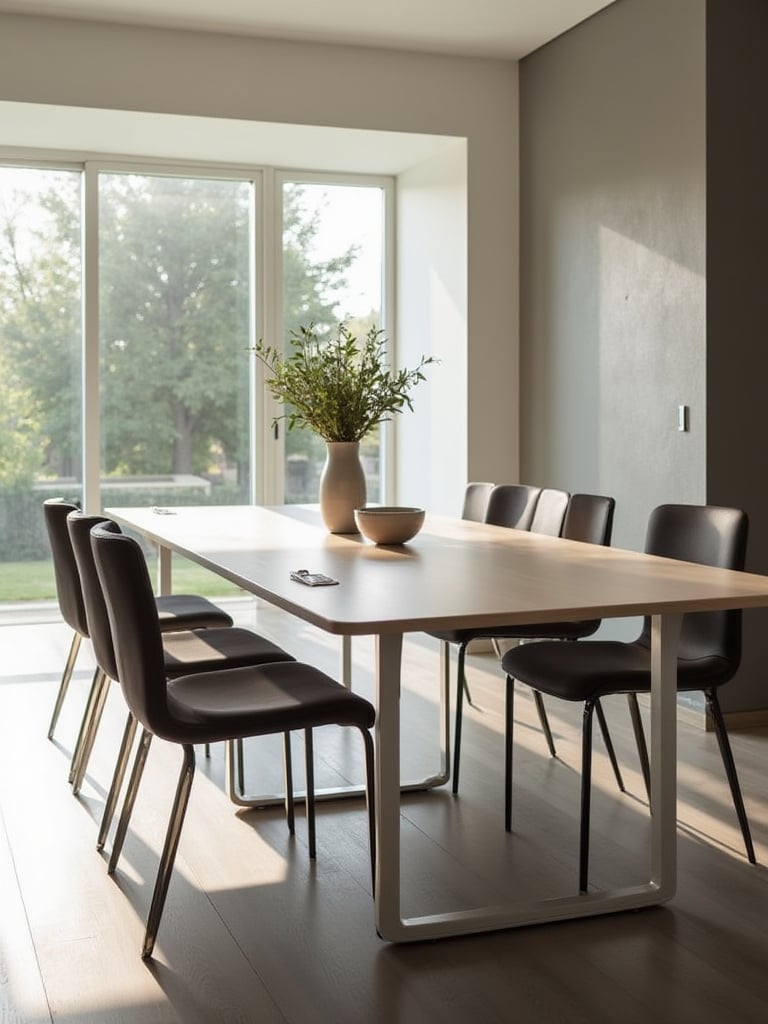
This is where you find dining tables that expand for parties, benches with hidden storage inside, or a beautiful bar cart that can be rolled out of the way when you need more space. The best pieces integrate their extra functions so seamlessly you’d never even know they were there. It’s about creating a space that works harder, not one that looks more complicated.
This mindset can transform your dining room. It can be a place for morning coffee, an afternoon homework station, or a weekend craft zone, all without ever feeling messy or chaotic. It’s about building in flexibility so the room can serve you in all the ways you live.
This adaptability gets even better when paired with a little bit of hidden tech.
In a mindful home, technology should serve serenity. It should be invisible, working in the background to make your life easier and your experiences richer, without demanding your attention. In the dining room, this is all about effortless control over the environment.
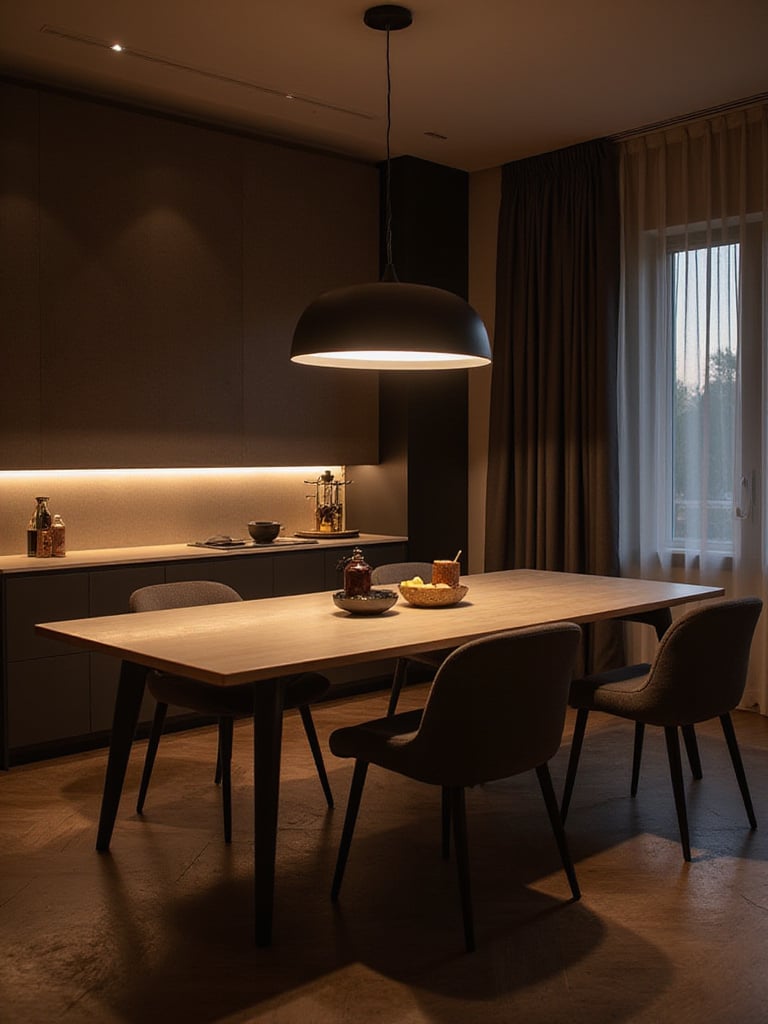
Imagine creating pre-set “scenes” with smart lighting. A “Dinner Party” scene might dim the overheads and turn on the accent lights. A “Homework” scene could brighten the task light over the table. A “Clean Up” scene could bring all the lights to full brightness. You can do the same with a smart thermostat or a hidden audio system that plays the perfect dinner playlist.
The goal is simplicity. You want systems that are intuitive for everyone to use, whether with a voice command, a simple app, or a sleek wall panel. It’s about using technology to remove friction so you can be more present in the moment.
That sense of ease and presence can be enhanced by a classic design trick.
Mirrors are magic. They are one of the most powerful tools we have for manipulating the sense of space and light in a room. When placed thoughtfully, a mirror can make a dining area feel larger, brighter, and more open.
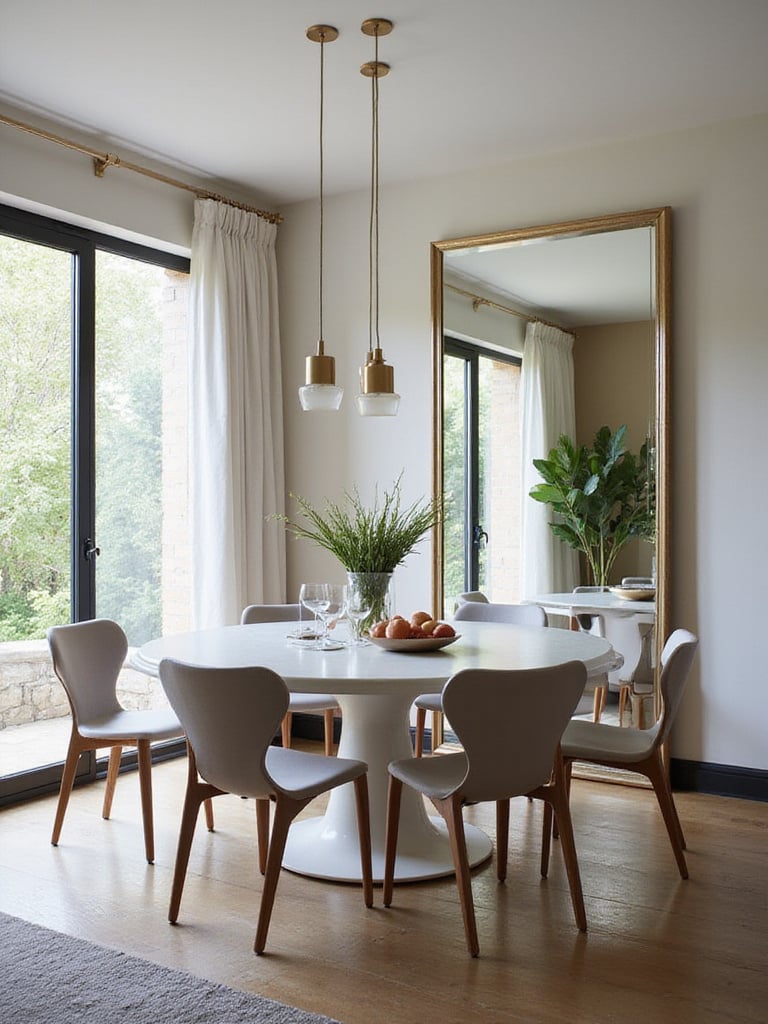
Here’s the secret: a mirror should always reflect something beautiful. Place a large mirror opposite a window, and you’ve essentially doubled your natural light. Position it to reflect a favorite piece of art or your stunning chandelier, and you create layers of depth and interest.
In contemporary design, I lean towards oversized mirrors with very simple, minimal frames. The idea is for the mirror to feel like an architectural element—almost like another window—rather than just a decorative object. The effect is profound. It creates a sense of possibility and expansiveness that can make any meal feel more special.
With the room feeling open and bright, let’s turn our attention to the table itself.
You don’t need three different sets of china to be ready for any occasion. A versatile table setting is about building a beautiful, practical foundation that you can easily dress up or down. It’s about intentionality, not excess.
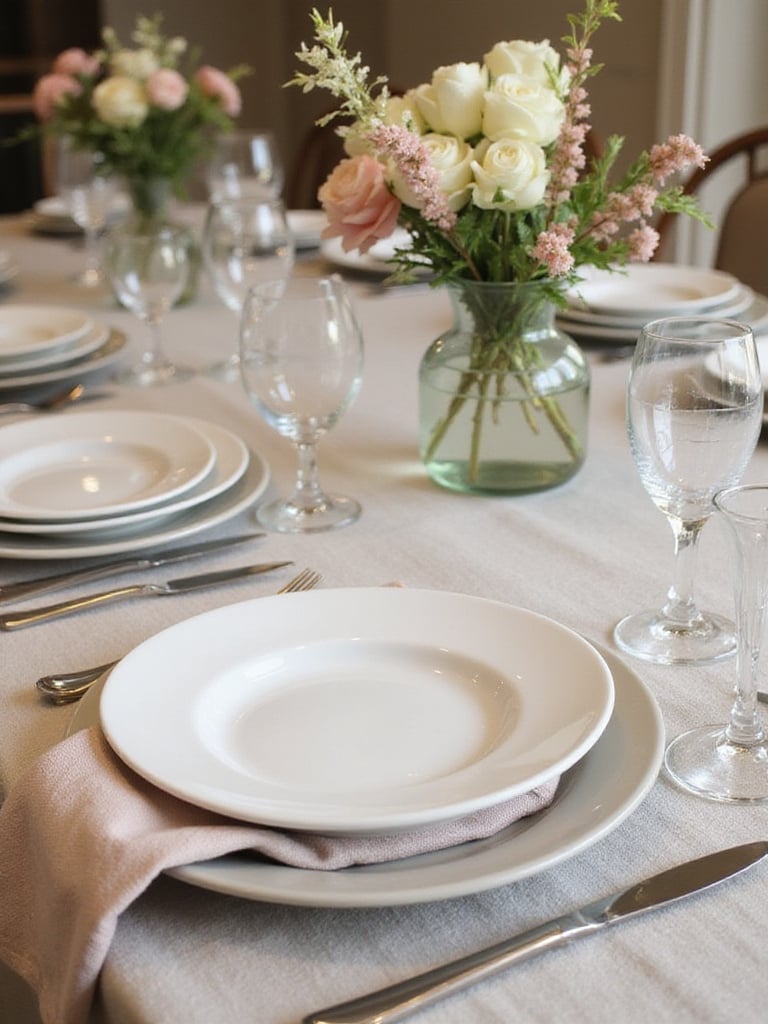
Start with a set of high-quality dinnerware in a classic, neutral color like white or cream. Simple, clean lines will work for everything from a Tuesday night taco dinner to a formal holiday meal. Then, build your layers. Invest in cloth napkins in a few different colors and textures, a set of beautiful placemats, and maybe some simple chargers. These are the elements you can swap out to completely change the mood.
The goal is to create a system that makes setting a beautiful table feel effortless and fun, not like a chore. This frees you up to focus on what really matters: your guests.
A great companion to a versatile table is a dedicated spot for hospitality.
A bar cart is more than just a trend; it’s a wonderfully functional piece that brings a touch of sophistication and ease to entertaining. It creates a dedicated station for drinks, which keeps your dining table clear and encourages guests to help themselves, allowing you, the host, to relax and be part of the party.
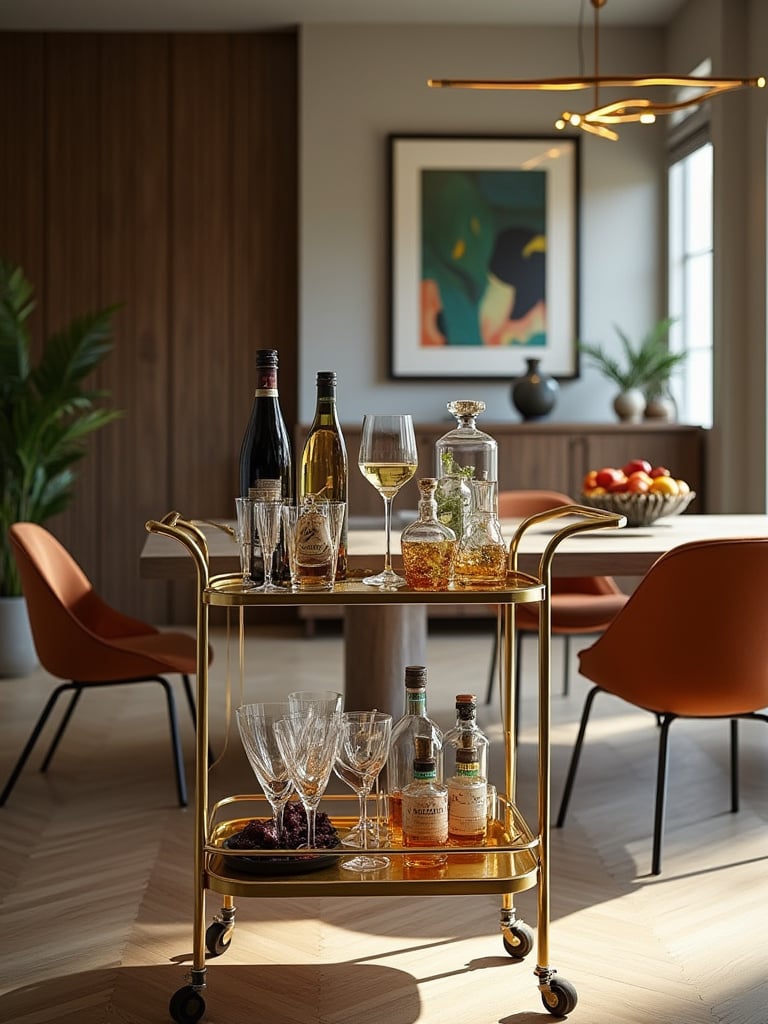
Choose a cart that feels like a piece of furniture, complementing your room’s materials and style. A sleek chrome and glass cart gives a very different feel than one made from warm walnut and brass. Stock it thoughtfully with the basics, some beautiful glassware, and maybe a small plant or a couple of art books. It should feel curated and integrated into the room.
The beauty of a cart is its mobility. You can roll it wherever it’s needed, making it an incredibly flexible tool for modern hospitality.
This sense of curation applies not just to objects, but to the very walls of the room.
A textured wall treatment can completely transform a room, turning a flat, boring surface into something dynamic and rich. It adds a layer of subtle complexity that engages the senses and creates a beautiful play of light and shadow throughout the day.
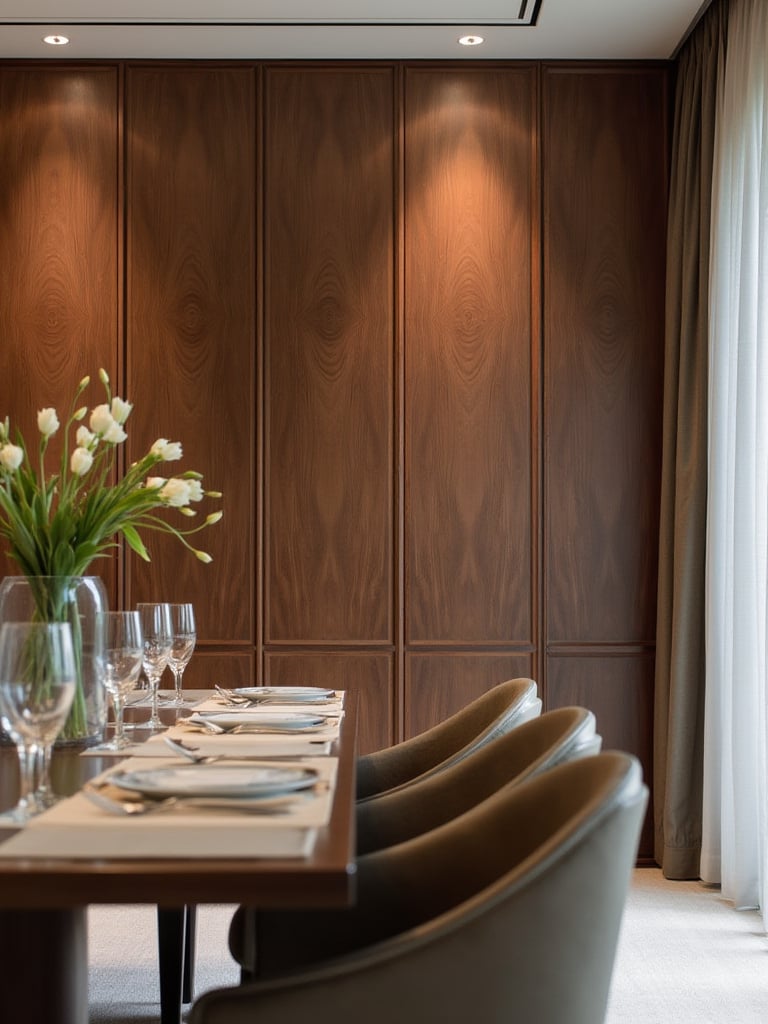
This doesn’t have to be a full-on ’70s popcorn ceiling. Think of elegant fluted wood panels that add a sense of rhythm and warmth, a soft limewash finish that creates beautiful, cloud-like variations in color, or even plaster with a subtle, hand-troweled texture. The goal is to add sensory interest without overwhelming the room’s sense of calm.
Lighting is key to making texture pop. Lights that “graze” the wall from above or below will accentuate the shadows and make the texture come alive. It creates a surface that invites you to look closer and adds a layer of quiet sophistication to the space.
The materials we choose for these treatments, and for everything in the room, tell a story.
Mindfulness extends beyond our own well-being to the well-being of the planet. Choosing sustainable materials for your dining room is a way to align your home with your values. Often, these choices also lead to higher-quality pieces that are healthier for you and will last a lifetime.
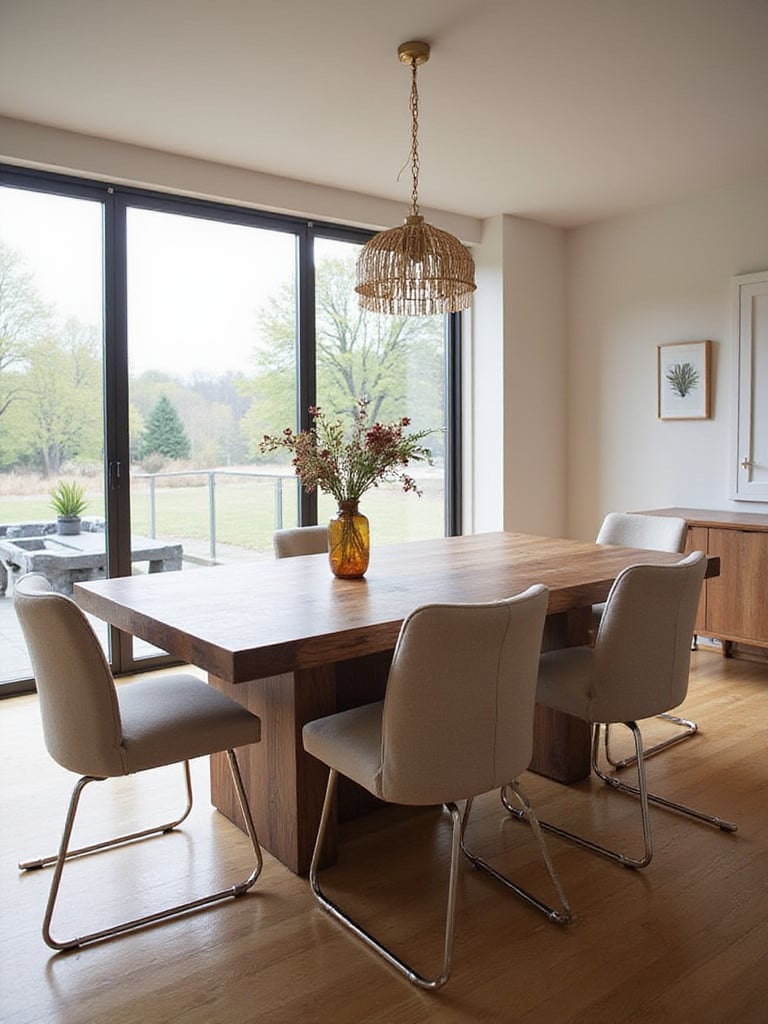
Look for furniture made from reclaimed wood or wood certified by the Forest Stewardship Council (FSC). Ask about low-VOC (volatile organic compound) finishes and adhesives, which are better for your indoor air quality. I am always so inspired by materials like recycled plastics or metals that have been transformed into stunning, high-end designs.
There’s a beautiful durability to sustainable materials. A solid wood table won’t end up in a landfill in five years; it will develop a rich patina, gathering the stories of all the meals and conversations shared around it. Knowing the story behind a piece—where the materials came from, who made it—adds a profound layer of meaning to your space.
That meaning is amplified by the final, most important layer.
This is the most important step of all. Personal accessories are what make a beautifully designed room feel like home. It’s not about filling shelves with “decor.” It’s about curating a small collection of objects that hold genuine meaning for you.
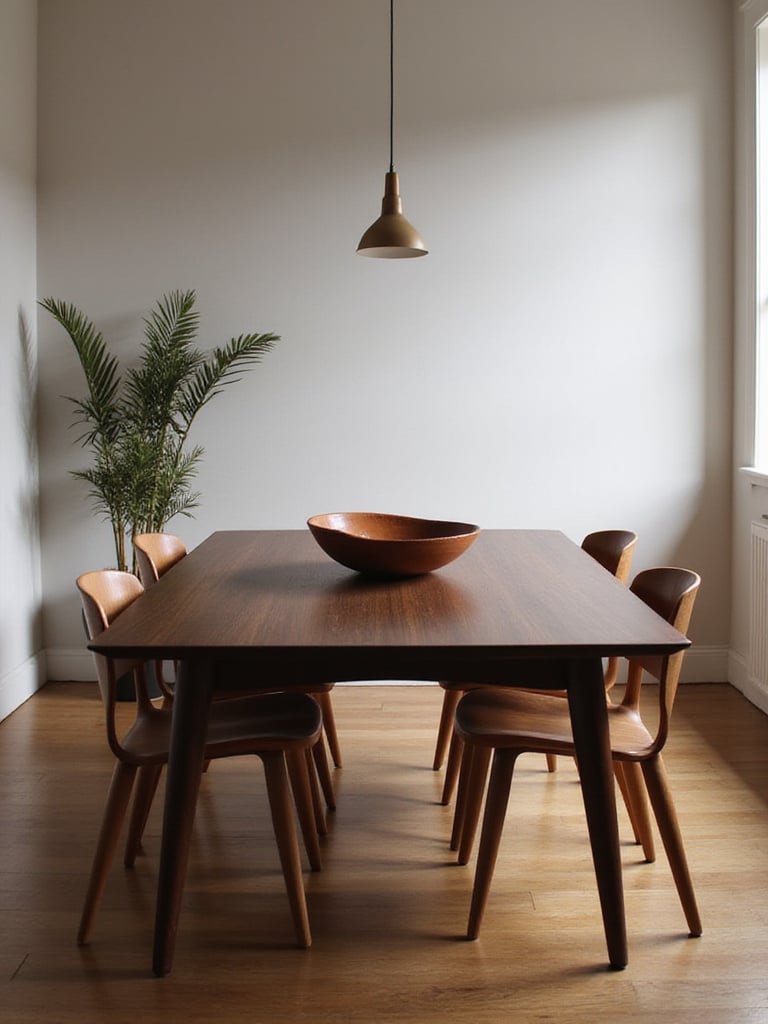
Maybe it’s a ceramic bowl you bought from a local artist whose work you love. A collection of smooth stones from a memorable family trip to the beach. A single, sculptural piece of driftwood that reminds you to find beauty in imperfection. These are the things that tell your story.
In contemporary design, empty space is just as important as the objects you display. Resist the urge to fill every surface. Group items in odd numbers, vary their height and texture, and give each meaningful piece room to breathe. The result is a space that feels deeply personal, authentic, and soulful.
Finally, we zoom out to see how this beautiful room connects to the rest of your home.
In most modern homes, the dining room doesn’t exist in a vacuum. Creating a seamless, energetic flow between it and the adjacent living areas makes your whole home feel more connected and expansive.
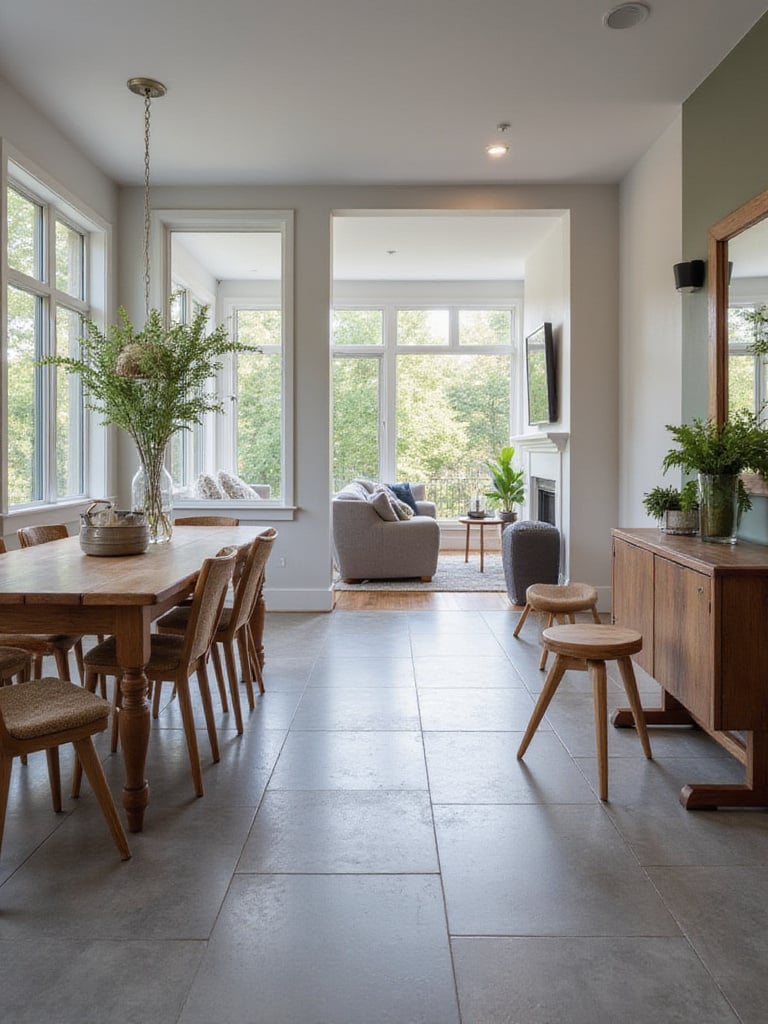
You can achieve this through a consistent foundation. Using the same flooring throughout the main living areas is a powerful unifier. A coordinated color palette, where colors from one room appear as accents in the next, also creates a strong sense of cohesion. Think about sightlines. Can you be in the kitchen and still feel part of the conversation at the dining table? That’s good flow.
The goal is to create what designers call “borrowed space,” where each area feels bigger because it visually connects to the next. It’s about creating gentle transitions, not hard stops. This makes your dining room feel both like its own special sanctuary and an integrated part of your home’s welcoming heart.
Designing a contemporary dining room is an act of intention. It’s a process of balancing beauty with function, and style with soul. When you thoughtfully weave these ideas together, you create more than just a pretty room. You create a space that supports what matters most: nourishing your body, connecting with people you love, and making memories that will last a lifetime.
Remember, this is not about rigid rules. It’s about understanding the principles that help you craft a space that truly reflects who you are. Trust your intuition. Let your personal story be your guide. Your dining room should be a sanctuary that makes every meal, from a quiet breakfast for one to a lively feast with friends, feel just a little more sacred.